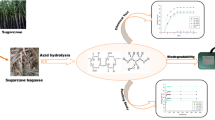Abstract
A combined (enzymatic and chemical) process using a Bacillus pumilus strain (DKS1), isolated from the soil, was used to degum ramie bast fibres. After 24 h of incubation with the isolated pectinolytic strain using a low-cost medium, the weight loss of the ramie fibre was found to be 25% under small scale. High activity of pectate lyase was detected in the culture supernatants; 400 kg of ramie fibres was degummed with 24% weight loss in large-scale degumming under field conditions. No cellulase activity was found. Microbial intervention followed by mild (0.1%) alkali treatment showed high percentage of weight loss from the ramie fibre. Bacterial degumming followed by chemical treatment resulted in an increase of single fibre tenacity (cN/tex) by more than 20.81% as compared to non-degummed (decorticated) fibre samples. Scanning electron micrographs (SEM) and fluorescence microscope showed that after Bacillus pumilus DKS1 treatment the surface of the decorticated ramie fibre becomes very smooth. These results indicate the process provides an economical and eco-friendly method for the small scale as well as large-scale degumming of decorticated ramie fibre. This study has great relevance to the textile as well as paper industry.



Similar content being viewed by others
References
Voragen FGJ, Heutink R, Pilnik W (1980) Solubilization of apple cell walls with polysaccharide degrading enzymes. J Appl Biochem 2:452–468
Osborne JM, Dehority BA (1989) Synergism in degradation and utilization of intact forage cellulose, hemicellulose, and pectin by three pure cultures of ruminal bacteria. Appl Environ Microbiol 55:2247–2250
Whitaker RJ (1989) Microbial pectolytic enzymes. In: Fogarty WM, Kelly CT (eds) Microbial enzymes and biotechnology. Elsevier, London, pp 133–175
Herron RS, Jacques AEB, Scavetta RD, Visser J, Jurnak F (2000) Structure and function of pectic enzymes: virulence factors of plant pathogens. Proc Natl Acad Sci USA 97(16):8762–8769. doi:10.1073/pnas.97.16.8762
Bhattacharyya SK, Paul NB (1976) Susceptibility of ramie with different gum contents to microbial damage. Curr Sci 45:417–418
Sharma HSS (1987) Screening of polysaccharide-degrading enzymes for retting flax stem. Int. Biodeterior Bull 23:181–186. doi:10.1016/0265-3036(87)90053-4
Baracat MC, Valentin C, Muchovej JJ, Silva DO (1989) Selection of pectinolytic fungi for degumming of natural fibers. Biotechnol Lett 11:899–902. doi:10.1007/BF01026849
Gillespie AM, Keane D, Griffin OT, Tuohy GM, Donaghy J, Haylock WR, Coughlan PM (1990) The application of fungal enzymes in flax retting and the properties of an extracellular polygalacturonase from Penicillium capsulatumn. In: Kirk TK, Chang HM (eds) Biotechnology in pulp and paper manufacture. Butterworth-Heinemann, Stoneham, pp 211–219
DasGupta PC, Sen K, Sen KS (1976) Degumming of decorticated ramie for textile purposes. Cell Chem Technol 10:285–291
Paul NB, Bhattacharyya SK (1979) The microbial degumming of raw ramie fibre. J Textile Inst 12:512–517
Deshpande KS, Gurucharanam K (1985) Degumming of ramie fibres: role of cell wall degrading enzymes of Aspergillus versicolor. Ind J Bot 8:79–81
Basu S, Ghosh A, Bera A, Saha MN, Chattopadhyay D, Chakrabarti K (2008) Thermodynamic characterization of a highly thermoactive extracellular pectate lyase from a new isolate Bacillus pumilus DKS1. Bioresour Technol 99(17):8088–8094. doi:10.1016/j.biortech.2008.03.032
Roberts PD, Phyllis MB, Caitilyn A, Yerlyn KS, George HL, Mark SM (1986) Requirement for two or more Erwinia carotovora subsp. Carotovora pectolytic gene products for maceration of potato tuber tissue by Escherichia coli. J Bacteriol 167:279–284
Bekri AM, Desair J, Keijers V, Proost P, Leeuwen SM, Vanderleyden J, Broek VA (1999) Azospirillium irakense produces a novel type of pectate lyase. J Bacteriol 181(8):2440–2447
Hebeish A, El-Bazza S (2003) Single stage process for desizing, scouring, and bleaching of cotton fabric. Angew Makromolekulare Chem 129(1):169–188. doi:10.1002/apmc.1985.051290114
Sirisart Q, Robert AS (2005) Morphology and structure of hemp fibre after bioscouring. Macromol Biosci 5(2):124–134. doi:10.1002/mabi.200400151
Booth JE (1968) Principles of textile testing, 3rd edn. pp 371–372
Dave BA, Vaughn RH (1971) Purification and properties of a polygalacturonic acid trans-eliminase produced by Bacillus pumilus. J Bacteriol 108:166–174
Zheng L, Du Y, Zhang J (2001) Degumming of ramie fibers by alkalophilic bacteria and their polysaccharide-degrading enzymes. Bioresour Technol 78:89–94. doi:10.1016/S0960-8524(00)00154-1
Kapoor M, Kuhad RC (2002) Improved polygalacturonase production from Bacillus sp. MG-cp-2 under submerged (SmF) and solid state fermentation (SSF). Lett Appl Microbiol 34:317–322. doi:10.1046/j.1472-765X.2002.01107.x
Sharma DC, Satyanarayana TA (2006) marked enhancement in the production of a highly alkaline and thermostable pectinase by Bacillus pumilus dcsr1 in submerged fermentation by using statistical methods. Bioresour Technol 97:727–733. doi:10.1016/j.biortech.2005.04.012
Acknowledgments
We are very grateful to Prof. Anjan Kumar Dasgupta (Biochemistry Department, University of Calcutta, India) for developing the fluorescence microscopy image of the treated ramie fibre. We are also grateful to Dr. Asish Mukherjee (Institute of Jute Technology, Kolkata, India) for the fibre tenacity measurement. The authors also acknowledged the support from Dr. Himadri Sekhar Sen (former director, CRIJAF, West Bengal, India). This study was also supported by a grant from the Special Assistance Programme of the Department of Biochemistry, University Grants Commission, India. This work has been supported by Indian Council of Agricultural Research (ICAR), India.
Author information
Authors and Affiliations
Corresponding author
Rights and permissions
About this article
Cite this article
Basu, S., Saha, M.N., Chattopadhyay, D. et al. Large-scale degumming of ramie fibre using a newly isolated Bacillus pumilus DKS1 with high pectate lyase activity. J Ind Microbiol Biotechnol 36, 239–245 (2009). https://doi.org/10.1007/s10295-008-0490-y
Received:
Accepted:
Published:
Issue Date:
DOI: https://doi.org/10.1007/s10295-008-0490-y




